
High Plains Gardening
The gardening website of the Texas High Plains Region
The Tulip in Europe
 “In 1123, the tulips are already mentioned in Russian literature under their Russian name “Lola” although this word is not of Russian but of Turkish origin {lale}, its use here indicates that also in Russia tulips had become known much earlier than in western Europe.” (Botschantzeva, Tulips, p.2. from “In Gardens and Gardening' (1951), article by Rollo Meyer). Except for this reference quoted in Botschantzeva's Tulips, there is no recording in medieval manuscripts of tulips growing in Europe, and no mention of a tulipomania in Russia, however, tulips grew wild in Asian and European Russia.
“In 1123, the tulips are already mentioned in Russian literature under their Russian name “Lola” although this word is not of Russian but of Turkish origin {lale}, its use here indicates that also in Russia tulips had become known much earlier than in western Europe.” (Botschantzeva, Tulips, p.2. from “In Gardens and Gardening' (1951), article by Rollo Meyer). Except for this reference quoted in Botschantzeva's Tulips, there is no recording in medieval manuscripts of tulips growing in Europe, and no mention of a tulipomania in Russia, however, tulips grew wild in Asian and European Russia.
The Medieval period was brought to an end by the fall of Constantinople in 1453 (some say the discovery of America in 1492), ushering in the Renaissance. A reference to tulips as Lils rouges (illustration at left) was described by a Zürich physician and natural scientist, Conrad Gesner, April 1559 after seeing it flowering for the first time in the garden of Johann Heinrich Herwart of Augsburg, Bavaria, saying it had come from Constantinople, or Cappadocia (referring to the Ottoman Empire), an area north of the Taurus Mountains in Asian Turkey. The sketch he drew showed six red petals (the number species tulips have), however, his description noted eight petals, calling it Tulipa turcarum. Possibly this was a sport or mutation. This wasn't the first European sketch of a tulip, “Gesner himself had already seen a sketch of another specimen, yellow this time . . . sent to him by his correspondent Johann Kentman from Padua, Venice. . . .” (Dash, p. 33.)
The sixteenth century brought many changes to Europe. Along with an openness to learning, trade to new worlds brought new wealth. It became fashionable for not just the rulers, but the wealthy to spend their new wealth on culture, whether it was art or music, and also gardens. New plants from new worlds coming into the market were highly prized and desired.
Tulips and tulip entrepreneurs hit the ground running. “There were tulips in Vienna by 1572. They were in Frankfurt by 1593, and they reached the south of France by 1598 (possibly much earlier). Bulbs reached England as early as 1582, where they were soon grown in great quantity. Before the end of the sixteenth century, endless ranks of new hybrids each more colorful than the last, had already begun to make their appearance . . .” (Dash, p. 34).
Carolus Clusius, Father of the Tulip
The story of tulips, as the story of anything, is a story of connections. Chance encounters at the right moment by the right person with the knowledge and vision to act. Such was the case of the arrival of the tulip to the shores of Antwerp in 1562. Cargo aboard a merchant ship carrying cloth from Istanbul included some tulips. Thinking they were onions from Turkey (an honest mistake, as Turkey is home to roughly 94 species of alliums), the Dutch merchant planted them in his kitchen garden. To his dismay, the flower was not one of an onion, but one he had never seen before. Not dismay, but delighted, was Joris Rye, a friend, businessman and keen botanist. Not recognizing the tulip as a flower he was familiar with either, Rye was allowed to transplant the bulbs into his own garden in Mechelen, and began a correspondence about this wonderfully strange new plant. The educated classes carried on steady correspondence with their learned friends across Europe. One of Rye's most avid correspondents was Carolus Clusius. (Dash, p. 36-37.) Tulip at left is most probably Tulipa clusiana 'Lady Jane', the species named after Carolus Clusius.
Clusius, born in Catholic France, traveled in Antwerp, France, Spain, Portugal and England exploring the countryside in his study of  botany, at that time a branch of the medical profession. He wrote an extensive list of plants he encountered in the wild and in gardens, exploring their usefulness as medicinals or herbs. Clusius's reputation grew, writing books and carrying on a prodigious correspondence; he was proficient in nine languages. His path crossed with Busbecq in Vienna, and similar to all passionate gardeners, exchanged knowledge, seeds and plants. Clusius grew gardens filled with many of the plants he later became known for, tulips, Fritellaria 'Crown Imperial', irises, hyacinths, anemones, ranuculus, narcissus and lilies. (The woodcut of the tulip is from Rariorum aliquot stirpium per Hispanias observatarum historia (1576) and is in the collection of the University of Leiden, photo at right is of Clusius .)
botany, at that time a branch of the medical profession. He wrote an extensive list of plants he encountered in the wild and in gardens, exploring their usefulness as medicinals or herbs. Clusius's reputation grew, writing books and carrying on a prodigious correspondence; he was proficient in nine languages. His path crossed with Busbecq in Vienna, and similar to all passionate gardeners, exchanged knowledge, seeds and plants. Clusius grew gardens filled with many of the plants he later became known for, tulips, Fritellaria 'Crown Imperial', irises, hyacinths, anemones, ranuculus, narcissus and lilies. (The woodcut of the tulip is from Rariorum aliquot stirpium per Hispanias observatarum historia (1576) and is in the collection of the University of Leiden, photo at right is of Clusius .)
It was during the sixteenth century that Martin Luther broke from the Catholic Church and the Protestant religion developed as a rival, not to be taken lightly by the Church. Clusius too, broke from the Catholic Church, a very risky enterprise in that day. Traveling throughout Europe in Catholic countries was dangerous, as heretics were burned at the stake or otherwise killed in an effort to save them. In the course of time, Clusius moved between Catholic and the Protestant parts of Europe, first to Germany, then Vienna, then on to the Netherlands, earning him a reputation as a scholar, disregarding his personal safety for his profession. (Dash, p. 38-39.)
 As a result of Clusius' growing reputation, at the age of 62, he was offered a job as Horti praefectus at Leiden’s new university (in the province of South Holland) to lay out a physic garden, or hortus academicus (picture at left in 1610), bringing his seeds and especially bulbs along with him in 1593. By this time, he had most certainly seen tulips growing in the Rey's
As a result of Clusius' growing reputation, at the age of 62, he was offered a job as Horti praefectus at Leiden’s new university (in the province of South Holland) to lay out a physic garden, or hortus academicus (picture at left in 1610), bringing his seeds and especially bulbs along with him in 1593. By this time, he had most certainly seen tulips growing in the Rey's  garden in Mechelen. Over his lifetime, Clusius is credited with singlehandedly transforming the appearance of gardens in northern Europe by generously distributing crown imperials (fritilarias) irises, hyacinths, anemones, ranuculus, narcissus, lilies and of course, tulips. Clusius hard life had aged him, suffering from numerous ailments by the time he took up the position in Leiden. Along with the position came an assistant to do the hard physical work, Dirck Cluyt. Fraught with the usual travails of establishing new gardens, the Low Countries and Northern Europe experienced a particular period of cold and wet winters, when many of the plants of the garden died. It was recorded that mice ate 150 of his precious tulip bulbs. Nonetheless, Clusius prevailed, advancing horticulture in general, and tulips in particular. Clusius wrote many treatises on tulips and other plants. Of note is his final work and masterpiece, Rariorum Plantarum Historia in 1601, from which much of the early history of the tulip in Europe is known. He wrote of the great diversity of the tulip and the ease new varieties could be propagated. Already by Clusius' day, there were a great many tulip cultivars. Botanists have identified fourteen species of tulips that produced the majority of Dutch cultivars in the seventeenth century, most notably, T. schrenkii, T. praecox, and T. clusiana, a tulip named in Clusius' honor known as the Lady Tulip, a red and white species tulip from the area of Iran and Afghanistan. It has many varieties and cultivars today, the most admired being ‘Lady Jane'. (Dash, Tulipomania.) (Photo at left is page 142 from Clusius' Rariorum Plantarum Historia.)
garden in Mechelen. Over his lifetime, Clusius is credited with singlehandedly transforming the appearance of gardens in northern Europe by generously distributing crown imperials (fritilarias) irises, hyacinths, anemones, ranuculus, narcissus, lilies and of course, tulips. Clusius hard life had aged him, suffering from numerous ailments by the time he took up the position in Leiden. Along with the position came an assistant to do the hard physical work, Dirck Cluyt. Fraught with the usual travails of establishing new gardens, the Low Countries and Northern Europe experienced a particular period of cold and wet winters, when many of the plants of the garden died. It was recorded that mice ate 150 of his precious tulip bulbs. Nonetheless, Clusius prevailed, advancing horticulture in general, and tulips in particular. Clusius wrote many treatises on tulips and other plants. Of note is his final work and masterpiece, Rariorum Plantarum Historia in 1601, from which much of the early history of the tulip in Europe is known. He wrote of the great diversity of the tulip and the ease new varieties could be propagated. Already by Clusius' day, there were a great many tulip cultivars. Botanists have identified fourteen species of tulips that produced the majority of Dutch cultivars in the seventeenth century, most notably, T. schrenkii, T. praecox, and T. clusiana, a tulip named in Clusius' honor known as the Lady Tulip, a red and white species tulip from the area of Iran and Afghanistan. It has many varieties and cultivars today, the most admired being ‘Lady Jane'. (Dash, Tulipomania.) (Photo at left is page 142 from Clusius' Rariorum Plantarum Historia.)
Although tulips were already being grown in Amsterdam and Leiden before Clusius' arrival, Clusius is given credit for the start and spread of tulips in the Netherlands. Part of this credit is because of a major organized theft of Clusius' tulips. As in many economies, industrious people are always in the lookout to spot a new trend or product. Such was the case in Leiden.
At this time, something strange was happening to tulips. An occasional break or broken tulip would develop. A broken tulip is a tulip exhibiting streaks or flames of color, where the previous year the color was solid and uniform. Further, offsets produced by broken tulips will reproduce true to the original broken tulip. Of course, the science of what made this mysterious breaking occur was unknown. No one could figure out how this happened, a sold colored tulip bulb would bloom into a flamed beauty. Flamed refers to when the color runs up the middle of each petal and branches out toward the edges. Feathering at the edges is always present as well. (Jacobs, Tulips) All agree it was a highly desirable occurrence, with gardeners and botanist trying many different ways to get their tulips to break.
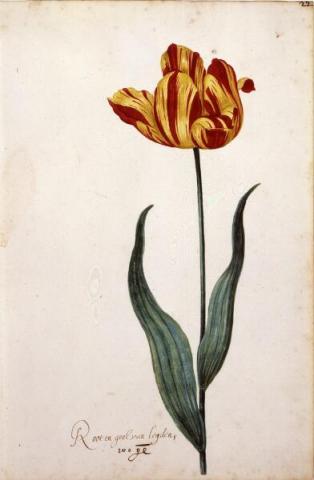 Wild or species tulips don't “break”. But the many cultivars already available were susceptible to breaking. Today we understand the breaks are caused by a virus carried by a peach aphid. The practice of many Dutch gardeners was to plant tulip bulbs within their vegetable gardens and orchards. “The virus works by partly suppressing the laid on color of a tulip, its anthocyanin, leaving the underlying color always white or yellow, to show through. The contrasting red or purple of a broken tulip looks as though it has been painted on the petals with a fine camel-hair brush. . . . The base of a broken tulip always remained pure white or yellow. The contrast between the purity of the base and the patterned petals was an important criterion of excellence among the florists who, from the middle of the seventeenth century, cultivated the tulip as one of six florist’ flowers, shown in keenly contested competition.” (Pavord, Tulips, p. 9.) (Picture of tulip at left: Root En Geel Van Leyden.)
Wild or species tulips don't “break”. But the many cultivars already available were susceptible to breaking. Today we understand the breaks are caused by a virus carried by a peach aphid. The practice of many Dutch gardeners was to plant tulip bulbs within their vegetable gardens and orchards. “The virus works by partly suppressing the laid on color of a tulip, its anthocyanin, leaving the underlying color always white or yellow, to show through. The contrasting red or purple of a broken tulip looks as though it has been painted on the petals with a fine camel-hair brush. . . . The base of a broken tulip always remained pure white or yellow. The contrast between the purity of the base and the patterned petals was an important criterion of excellence among the florists who, from the middle of the seventeenth century, cultivated the tulip as one of six florist’ flowers, shown in keenly contested competition.” (Pavord, Tulips, p. 9.) (Picture of tulip at left: Root En Geel Van Leyden.)
Throughout the later sixteenth and early seventeenth centuries, tulip growing, breeding, owning and coveting grew along with the desired phenomenon of breaking. The short stemmed wild tulips gradually were being crossed with each other to develop some of the beautiful flamed and feathered tulips, that were much prized and admired. Tulips reproduce by seed and offsets. Offspring are true to the original flower from the mother bulb, but not necessarily from seed. Offsets of broken tulips would produce broken flowers, but the flowers from seeds of broken flowers would not.
By this time, tulips were classified into thirteen groups or color schemes. The simplest were called the “Couleren, single colored tulips of red, white and yellow, and ranging up to the rare Marquetrinen, late flowering flowers that exhibited at least four colors.” (Dash, p. 58) the Couleren tulips would simply be called “breeder” tulips later on. The single colored tulips are thought to be botanical tulips, and tulips with more complex coloring to be cultivars. The most prized three basic categories were:
Some references infer Clusius jealously guarded his precious tulips, not willing to sell any, as they were becoming greatly coveted (Pavord, Tulips). However, Rev. Joseph Jacobs, in his book in 1912, Tulips, notes that Clusius frequently ordered fresh supplies of tulips from Constantinople gaining quite profitably from the sales, thus inciting jealousy and resentment from the townspeople. Michael Dash writes “he took pleasure in stocking the gardens of his friends” giving bulbs away, often for nothing. But this may be mincing details long in the past, whether Clusius sold or shared tulips or not. What is known is that plans were made and launched to steal them by night (something practiced regularly during tulipomania). Because of this theft, it is said Clusius lost heart and returned to his garden, this theft not the first he had experienced, most certainly the largest. The thief set about propagating tulips by seeds and offsets, selling and trading as fast as they could reproduce. Within just a few years, the tulip trade was off and running in the Netherlands. The flower was popular throughout Europe, but nowhere more popular than in the United Provinces.
Tulipomania 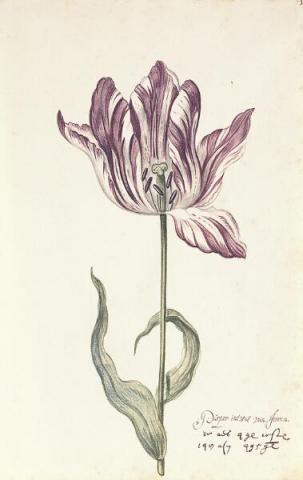
Just a short 40 years later, 'Tulipomania' struck the Dutch. It takes 5-7 years (most often 7) for tulip seeds to mature into a flower producing bulb — just 5 tulip generations later, the tulip craze had so captured the Dutch, that people would trade one bulb for as great a price as a house. These weren’t just the wild, species tulips imported from Turkey, but the flamed and feathered tulips.
Sultan Mehmed II (Mehmet II) of the Ottoman Empire actually help set up the tulip craze in the Netherlands after capturing Constantinople in 1453. Muslim Turks had tried to capture the Byzantine city for seven hundred years, laying siege century after century. One can imagine the political ramifications this wrought throughout the West. One of the actions of Mehmed II decreed was to close the trade routes, the Silk Road, to China. These routes stayed closed for about a century when they were opened up by Suleyman the Magnificent (at the time of Busbecq).
Europeans had for centuries been accustomed to goods from the Orient. Fearful of a long term trade war, European countries, chiefly Spain, Portugal, the Dutch and England set about looking for a new trade route to China, this time, a maritime Silk Road to bypass the Muslim Turks.
The Dutch East India Company was formed in 1602. The Dutch are and were an industrious people. They were coming off of a recession that had lasted nearly the entire decade of the 1620's. During the early seventeenth century, the Dutch economy was on an up-tic, colonization and trading across the seas was at a high, which led to a thriving merchant class with plenty of disposable new found wealth. The tulip was already well establish in Dutch gardens during the first quarter of the seventeenth century, as portrayed by the Flemish artist Jan Brueghal, 'Allegory of Spring', painted in 1616. Art of the Dutch Golden Age featured both broken and plain colored tulips in paintings and as motifs on delftware. (Painting at right: by Bosschaert.)
As one economist analyzed it, all that was needed was the right commodity; speculation increasing with its rarity (Pavord, Tulips, p. 157) . These infected bulbs produced offspring true to the prized specimen, each bulb, their offsets and seeds became equally treasured. However, the virus also weakened the bulbs, reducing vigor, mottling the leaves, reducing the flower size, and after a few years each bulb would diminish and die in turn, increasing the value of the remaining relations. This period of tulipmania did not include double tulips (first noted in 1665) nor the parrot tulips (1690). (Jacobs, Tulips.) This was a a new plant in a new age of the world with new wealth. Everybody who was anybody wanted at least one.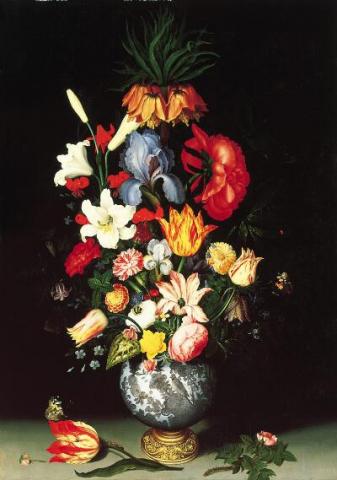
Another theory brought forth on the attraction of the tulip to the Dutch involved their climate and topography. A flat cold, cloudy and dreary climate for most of the year, the springtime blooming of exotic flowers from the Ottoman world was an otherworldly sight. Especially, as the extraordinary broken tulips increased in number, the desire to have one was irresistible.
Still another theory for the tulip's immense allure to the Dutch, was due to the schism between the Catholics and Lutheran Protestants. Some say the Protestants took to the tulip since it wasn't used as a religious motif in the Catholic Church. As immigrants fled the Catholic areas to the south of the United Provinces after the Dutch Revolt (throwing off the Catholic Spanish yoke), populations of Dutch cities exploded and labor was cheap. The advent of tulipmania coincided with an outbreak of the bubonic plague, the Black Death. Thousands died in the United Provinces, creating a labor shortage, and in turn higher wages for those who survived. There was a good deal more disposable income. Tulips weren't the average person's only investment, the average Dutch family invested in art, so much so it was a rarity for a home not to have at least one painting displayed on the walls, many have walls full of paintings.
This was a 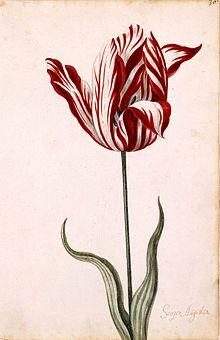 heady time in the Low Countries, an area bustling with trade, business and wealth, new religion and political ideas and the flourishing of the arts. Building of estates of wealthy merchants and gardens of the new burgher class accelerated the need for treasured plants to fill them, escalating their prices. Optimism for the future abounded.
heady time in the Low Countries, an area bustling with trade, business and wealth, new religion and political ideas and the flourishing of the arts. Building of estates of wealthy merchants and gardens of the new burgher class accelerated the need for treasured plants to fill them, escalating their prices. Optimism for the future abounded.
Although this phenomenon of flamed and feathered tulips occurred with French, Flemish and English breeders, the Dutch breeders produced many and more beautiful broken tulips, one of the best called ‘Semper Augustus’ (1623) (photo at left), with red color streaks symmetrical set round the outside of the petals against a white background. ‘Semper Augustus’, said to be the most beautifully broken or marked tulip, was priced at 1200 guilders each. “This was the equivalent of three times the average annual wage in mid seventeenth century Holland, perhaps as much as £80,000 in modern terms.” (Pavord, p. 7) One guide to currency during 1632 has estimated a guilder’s worth was the equivalent of £24 for a value of £28,800 or $43,200 (However, I am unsure if they mean a Dutch guilder or German guilder, or if the value was the same.) Still a great deal of money for one bulb. I get shivers myself when looking at these beautiful botanic illustrations. As I researched, I fell into a sort of tulip mania, desire rising for one of the treasured gems.
Eventually, owning tulip bulbs wasn't the point; the point simply became trading for profit. The trades that flowered into tulip mania was in flower futures, not even present blooms. “At first the trade was undoubtedly legitimate, but as time went on it developed into a pure speculation, about which it may be said, if one thing is more certain that another, that the last thing that entered into a purchaser’s head was the wish to possess the bulbs he had theoretically bought. All classes of the community, even sweeps and servant girls, joined in the gamble. Much of the ordinary trade of the country was given up, and the usual occupations of the citizens were neglected — all, so that more time and money could be given up to the new way of getting rich.” (Jacobs, Tulips, from the Samenspruecken tusschen Waermondt ende Gaergoedt — Conversations Between Waermondt and Gaergoedt)
One of the extraordinary points about the Dutch Tulipmania was how short lived it was, from 1634 to 1637. Trading escalated slowly at first, as word spread, more and more people joined the trade, until in the later months of 1636, prices reached ridiculous levels, causing the ruin of many a speculator and florists who rushed in, especially in the last few months of the phenomenon. (Picture of 'Viceroy', A tulip displayed in a 1637 Dutch catalog. Its bulb cost between 3,000 and 4,150 guilders or florins, depending on size.)
As an example of the tulips' inflated value, a tulip bulbs selling for 3000 guilders would have purchased an enormous amount of goods, including:
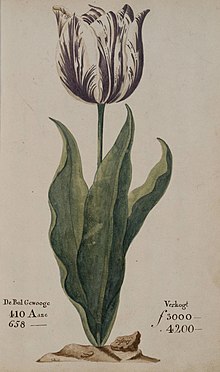
Totalling 3,000 guilders
Tulip bulb trading reached it's peak in January, 1637. On February 3, an allotment of tulips went up for trade, but no bidders came forward. Another lot was offered, again met with silence. News quickly spread to surrounding cities. Several buyers and sellers continued to trade in an effort to prop up the price, which proved fruitless. All of a sudden, tulips that might bring 5000 guilders could barely find a buyer at 50 guilders, a bed of tulips expected to raise 600 – 1000 guilders, brought 6. Many people, both common and wealthy faced ruin. Over an 18 month period, various solutions were passed by local governing councils in resolution of the crisis, each Dutch city proposing a way out of the financial chaos. Finally, in May, 1638 it was determined that contracts could either be honored or defaulted, but the defaulting buyer could extricate himself by paying 3.5% of the value of the contract to the seller, the seller retaining the tulips. Sellers weren't obligated to accept, but most did, thus avoiding expensive and lengthly litigation.
Tulip trading, tainted by the craze, took a little dip, as people went about their business licking their wounds. With the speculators removed from the scene, the true tulip connoisseurs and wealthy regents continued on, purchasing and growing tulips, especially when prices returned to reasonable levels. Any slack in the tulip trade was soon taken up with international trade, as the Dutch East India Company brought in goods from around the world for the European markets, goods, including bulbs, were exported back out.
The soils of the Low Countries are ideally suited to the cultivation of tulips, sandy yet rich with abundant winter and spring moisture. The problem of excessive summer moisture was solved by lifting the bulbs after the foliage has completely yellowed and storing them for planting in the fall. This practice continues today with the 4 - 8 billion bulbs it produces each year, providing 80% of the world market.
Other Minor Manias
Less remembered today was a mini-mania for hyacinths. The appreciation and cultivation of hyacinths, too, continued through the centuries alongside the tulip admiration. A third edition of Zamenspraecken published in 1734, issues a warning against a hyacinth mania. (Jacob, Tulips) Dahlias too inspired a certain degree of mania in France around 1838. Dutch gladioli in 1912. More recently, a Chinese mania for the red spider lily, Lycoris radiata, burst forth in 1985. The red spider lily was cultivated for decades by the ruling class in the Manchurian city of Ch'ang-ch'un. In the 1980's with the loosening of economic restrictions of it's people, more Chinese acquired more disposable income, and indulged in the distinction of owning and growing the spider lily, with some varieties selling for as much as $50,000! (Dash, p. 218- 220.)
Today, there is a minor fever for the snowdrop, Galanthus. Long loved in England, Recently this year, the price of some rare Galanthus skyrocketed 'Humpty Dumpty' from £75 to £195 for one bulb. Back in February, 2012, one 'Elizabeth Harrison' bulb sold for £725! A little pricey for me, rare or not.
References -- listed at the end of Part 4.
For Part 3, The Tulip in France and England, click here.
Angie Hanna, April 8, 2014